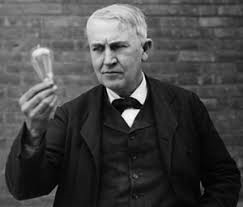January 6, 2018:

On January 6th, 1931, at the age of 84, Thomas Alva Edison filed his last patent application. The “Wizard of Menlo Park” died several months later leaving an incomparable legacy. After receiving his first patent at age 21, Edison would go on to be awarded 1,093 U.S. patents and over 1200 foreign patents. His record is only surpassed by Shunpei Yamazaki who holds over 5,000 worldwide patents, primarily in computer display technology.
In addition to the incandescent light bulb and the phonograph, Edison’s inventions range from the electric chair (although he opposed capital punishment) to an engraving device that would later be modified by Samuel O’Reilly to make the first tattoo machine. Edison was also a master at perfecting the work of other inventors, most notably, his contribution to the telephone.
A couple of disappointments
Edison had many inventions that did not enjoy success including electric cars and concrete houses.
Convinced that automobiles should run on electricity, Edison began work on a storage battery for cars in 1899. Edison’s goal was to produce a battery that would run for 100 miles without recharging. After 10 years, Edison gave up the project because of U.S. consumer access to inexpensive gasoline.
Always looking for ways to uplift society, Edison became fascinated with the potential of concrete to effect change. He envisioned the elimination of urban slums by mass-producing durable, inexpensive concrete homes. The cost for his home complete with indoor plumbing was 1/3 the price of a conventional house and Edison pledged to take no profits from the venture. The project failed primarily because builders balked at the high start-up costs.
The telephone
Alexander Graham Bell’s patent of the telephone in 1876 created a wave of court cases from competing inventors. Edison had filed a patent application for a similar device prior to Bell however Edison conceded that his device was more of a loud speaker than a telephone and declared that Bell was the rightful telephone inventor. Edison would improve Bell’s device with the invention of the carbon button transmitter (which is still found in land-line phones today). The transmitter significantly improved the telephone’s sound quality and made the device marketable. Western Union paid Edison an astounding $100,000 for the transmitter and launched a subsidiary to compete with Bell. After years of legal battles, the two inventors joined together to form the United Telephone Company. This allowed Edison to get back to his first love- inventing things.
The phonograph
Edison’s work on improving the telephone led to his invention of the phonograph. His major break-through was the use of specialized needles on tinfoil-coated cylinders to record and replay sound. Just as Edison had made the telephone commercially viable, Alexander Graham Bell was able to improve on the phonograph by replacing the flimsy tin foil cylinders with discs of wax, making the phonograph commercially viable. (I’m surmising that these two didn’t have a lot of time for golf or keg parties.)
The bulb
In 1802, 24-year-old British chemist, Humphry Davy created an incandescent light by passing electrical current through a strip of platinum. Thus, began a 75-year quest by scientists to perfect a commercially viable electric light. In 1878, Edison, backed by a group of investors, began research on an electric lamp. Edison’s work centered around creating a filament made of a carbonized thread. Initial materials tested for the filament did not produce a light that burned long enough to be practical. Determined to succeed, Edison’s team tested over 6000 materials until discovering that by using carbonized bamboo for the filament, a light bulb could burn for almost 600 hours. In 1880, the Edison Electric Light Company began marketing its new product.
One more thing about the telephone
As a former telecommunications sales guy, I’ve always loved the story about Edison’s contribution to telephone signaling. The telephone was designed to connect two offices over a direct open line. But, how would a person alert the other party that he wanted to speak? Some suggested using a bell or whistle while Bell himself advocated that the initiator shout “Ahoy”. On Aug. 15, 1877, Edison weighed in, writing that the caller should shout “Hello” into the device. Variants of “hello” had been used for many years in hound training but it was not a word people used to greet each other. In 1878, the first phone book was published in New Haven, instructing users to begin conversations with a “firm and cheery hello”. Unfortunately, the phone company’s instructions to say, “that is all” to end a conversation did not endure.
Have a great weekend.
That is all,
Ted Curtin
ted@blackdotmessaging.com
If you are looking for top-notch marketing support, contact www.blackdotmessaging.com
|